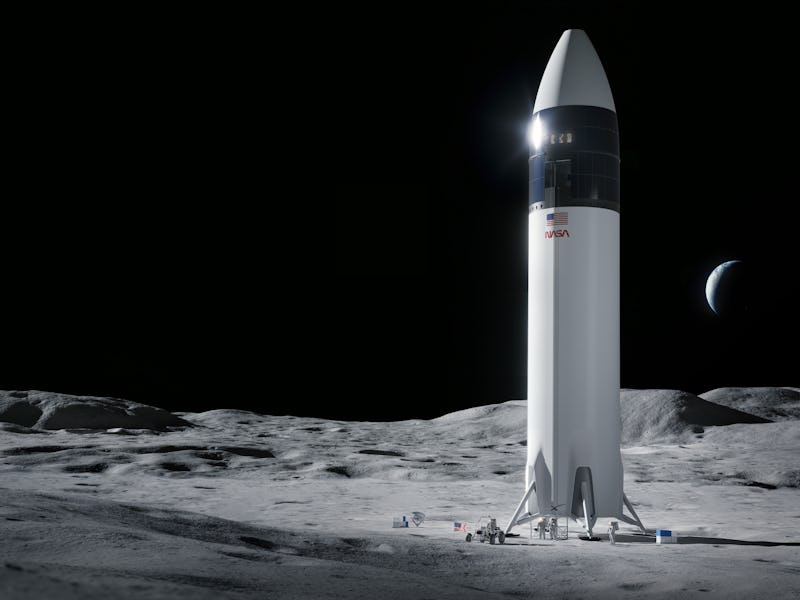NASA update: What Blue Origin's lawsuit means for crewed Artemis Moon missions
NASA might be going to the Moon a bit later.

NASA’s planned trip to the Moon has been held back by Earth-based lawsuits, the agency says.
After NASA chose Elon Musk’s SpaceX to develop a human lander for its mission in April, Jeff Bezos’ rival firm Blue Origin took legal action. On Tuesday, NASA administrator Bill Nelson claimed the agency “lost nearly seven months in litigation,” which “has pushed the first human landing likely to no earlier than 2025.”
The comments reflect the latest turn in one of the most bitter disputes in the new era of spaceflight. It also provides new clarity around NASA’s planned Artemis III mission, which will land the first woman and first person of color on the Moon.
Beyond earning Blue Origin the new “Sue Origin” nickname in some quarters, Nelson’s comments suggest Bezos’ team may have managed to delay the next Moon landing.
Nelson also blamed the Trump administration for the delay, as the “target of 2024 human landing was not grounded in technical feasibility.”
NASA’s Moon mission faced difficulties from both the Trump administration and Blue Origin. With the lawsuit over and a more realistic deadline set, the agency is now on its way to meet the challenge ahead.
NASA, SpaceX, and Blue Origin: Here’s the timeline of what happened
Trump announces Moon mission — On December 11, 2017, the 45th anniversary of the Apollo mission, Trump announced that the U.S. would return to the Moon. Trump signed Space Policy Directive 1 to set the new goal. A launch date was unclear.
“This time, we will not only plant our flag and leave our footprints,” he said. “We will establish a foundation for an eventual mission to Mars, and perhaps someday, to many worlds beyond.”
NASA's concept art for a lunar lander.
NASA aims for 2028 — On December 13, 2018, NASA announced plans to work with private American companies to develop a human lander system. This would be used to return humans to the Moon’s surface.
The announcement also reaffirmed NASA’s internal timeline to test the human-class landers on the Moon from 2024, before sending crew in 2028.
Pence sets 2024 — On March 26, 2019, vice president Mike Pence said NASA’s current goal was “just not good enough,” adding that “we’re better than that.” He noted how it only took the agency eight years to get to the Moon in the first place.
Calling on NASA to “adopt new policies and embrace a new mindset,” he declared the agency should send humans to the Moon by 2024.
Mike Pence speaking at NASA in 2020 after the launch of SpaceX’s first crewed mission.
Trump loses interest — On June 7, 2019, Trump posted on Twitter: “For all of the money we are spending, NASA should NOT be talking about going to the Moon – We did that 50 years ago. They should be focused on the much bigger things we are doing, including Mars (of which the Moon is a part), Defense and Science!”
NASA chooses three companies — On April 30, 2020, NASA announced that it had chosen three human lander designs from three different companies, one or two of which would be chosen to develop its design further:
- The Blue Origin National Team, which also includes Lockheed Martin, Northrop Grumman, and Draper
- Dynetics
- SpaceX
NASA chooses SpaceX — On April 16, 2021, NASA announced it would move ahead with the Starship lunar lander design. The firm-fixed price, milestone-based contract was worth $2.89 billion.
Blue Origin objects — Just 10 days later, on April 26, 2021, Blue Origin and Dynetics both protested NASA’s decision to the Government Accountability Office.
On May 1, 2021, NASA told SpaceX to stop working on the lander and wait for the outcome of these challenges.
On July 26, 2021, Blue Origin published an open letter from Bezos that cited several issues with the selection process. It stated that NASA would find itself with “limited options” as it chose to move ahead with one design instead of two.
Bezos also suggested that Blue Origin would bridge the budgetary shortfall with a waiver of up to $2 billion in payments, contribute to the development of a pathfinder mission, and accept a firm, fixed-price contract for the work.
The GAO doesn’t object — On July 30, 2021, the Government Accountability Office concluded that NASA did not act improperly when it awarded the single contract to SpaceX.
Blue Origin sues — On August 13, 2021, Blue Origin filed a lawsuit with the Court of Federal Claims.
Nelson hints at delay — On September 23, 2021, Nelson responded to a question about whether NASA could still meet its 2024 target with: “We don't know at this point. We're gonna move with all dispatch as soon as we know the legal realm, and then we can better answer your question."
Blue Origin loses — On November 4, 2021, Blue Origin lost its lawsuit.
“Not the decision we wanted, but we respect the court’s judgment, and wish full success for NASA and SpaceX on the contract,” Bezos wrote on Twitter.
The Inverse analysis — It was unclear how much of an effect Blue Origin’s move would have on the Artemis crewed mission, but NASA seems to suggest it has an answer.
The question is whether Blue Origin was really responsible for that much of a delay, or whether the Trump administration’s unrealistic deadline was more the issue. As Nelson even said the old deadline was not grounded in feasibility, it’s possible that Blue Origin’s legal moves gave NASA some room to adjust its launch dates.
One thing’s for sure: Blue Origin comes away from the fiasco with a damaged reputation and still no lunar contract.